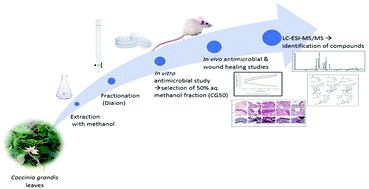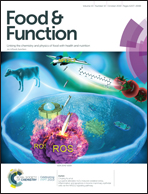Metabolic profiling of a polyphenolic-rich fraction of Coccinia grandis leaves using LC-ESI-MS/MS and in vivo validation of its antimicrobial and wound healing activities†
Abstract
A polyphenolic-rich fraction (CG50) was obtained from the methanol extract of Coccinia grandis leaves by chromatographic fractionation over a Diaion column using 50% aqueous methanol. LC-ESI-MS/MS analysis of CG50 showed the presence of six flavonoids, namely quercetin-hexoside deoxyhexoside (rutin), quercetin-hexoside deoxyhexoside (quercetin-3-O-neohesperidoside), kaempferol-hexoside deoxyhexoside (kaempferol-3-O-rutinoside), kaempferol-hexoside deoxyhexoside (kaempferol-3-O-neohesperidoside), kaempferol-3-O-glucoside, and kaempferol-hexoside in addition to the presence of two secoiridoids which are oleuropein and ligstroside. CG50 hydrogel showed a pronounced inhibition of the bacterial growth in wounds infected by Bacillus cereus in rats comparable to those treated with hydrogel base only showing 85.08 and 16.50% inhibition for the bacterial growth for the CG50 hydrogel and hydrogel base, respectively. The antimicrobial activity of CG50 hydrogel was close to that of fucidin during all days of treatment. Rats treated with CG50 hydrogel showed remarkable healing ability of the wound compared to other groups and approaching that of fucidin. This was clearly manifested by the clear formation of scars with obvious reduction in the wound size together with the appearance and re-growth of hair. This was further confirmed by the histopathological study of skin tissues as well as by the evaluation of the percentages of collagen fiber deposition. CG50 hydrogel showed 18.71% collagen fiber deposition comparable to the untreated group that showed 6.84% collagen fiber deposition and approaches that of the fucidin group. It was concluded that Coccinia grandis could be used as a natural wound healing agent that further consolidated its traditional use as a wound dressing.



 Please wait while we load your content...
Please wait while we load your content...